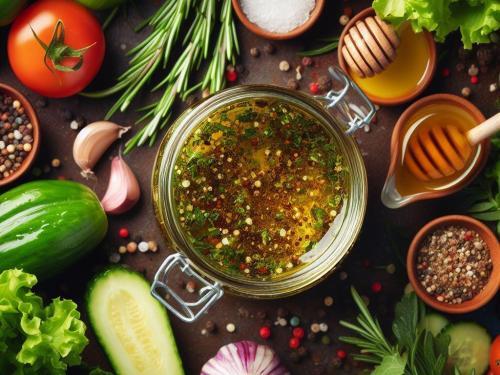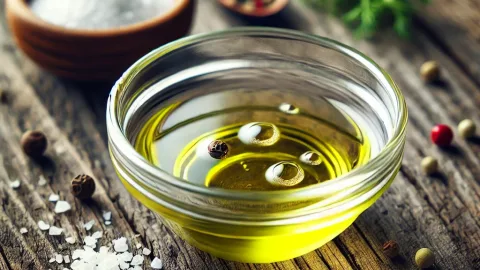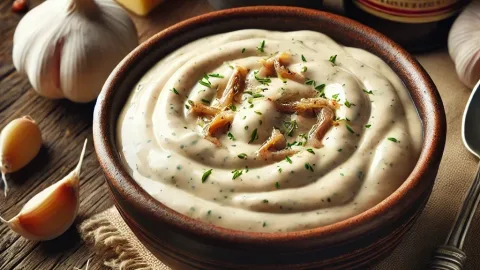Ingredients
Instructions
- Start by mixing the vinegar, salt, and pepper in a bowl, whisk this mixture well so that the salt dissolves completely.
- As you keep whisking, gradually add the oil to create a smooth emulsion.
- Taste and adjust seasoning with additional salt and pepper if needed.
Voedingswaarden
Variations: A world of flavors
Each variation of vinaigrette brings a unique twist to the traditional base. Whether it’s swapping vinegar for citrus, adding spices or mixing different oils, the possibilities are endless.Lemon Vinaigrette
- Additional ingredients: Replace the vinegar with fresh lemon juice.
- Applications: Perfect for light summer salads, grilled fish, or as a fresh marinade for chicken.
Lime Vinaigrette
- Additional ingredients: Replace the vinegar with fresh lime juice.
- Applications: Excellent on a taco salad, grilled shrimp, or a Thai style beef salad.
Mustard vinaigrette
- Additional ingredients: Add a teaspoon of Dijon mustard. Optionally, you can add clam cooking liquid, curry powder, chives, garlic, and ketchup for a richer flavor.
- Applications: Delicious with a traditional green salad, roasted vegetables or as a dip for pretzels.
Ravigote sauce
- Additional ingredients: Chopped onion and shallot, coarsely chopped parsley, chervil, tarragon, and chives, and rinsed and drained capers.
- Applications: Great with fried fish, poached eggs, or as a tangy dressing over a potato salad.
French-style vinaigrette
- Additional ingredients: Chopped onion and shallot, coarsely chopped parsley, and a teaspoon of Dijon mustard.
- Applications: A classic choice for mixed green salads, grilled asparagus, or over a Niçoise salad.
Flemish-style vinaigrette
- Additional ingredients: Chopped onion and shallot, and coarsely chopped parsley.
- Applications: Delicious over a Belgian style salad, grilled potatoes, or a cold pasta salad.
Italian vinaigrette
- Additional ingredients: Chopped shallot and onion, coarsely chopped parsley, crushed garlic, and brunoise of red, yellow and green bell bell pepper.
- Applications: Perfect for Caprese salad, antipasto dishes, or roasted Mediterranean vegetables.
Orange vinaigrette sauce
- Additional ingredients: 2 parts olive oil, half part nut oil, 2 parts honey vinegar, finished with orange juice, and seasoned with pepper, salt, and cayenne pepper.
- Applications: Delicious over a duck salad, roasted carrots, or a fresh citrus salad.
Vinaigrettes with special vinegars:
Sherry vinaigrette sauce
- Additional ingredients: Peanut oil, sherry vinegar, finished with sherry, salt and pepper.
- Applications: Excellent with a warm goat cheese salad, grilled mushrooms, or over a Spanish tapas dish.
Balsamic vinaigrette sauce
- Additional ingredients: Olive oil, peanut oil, white wine vinegar, balsamic vinegar, chopped cumin, pressed garlic, grated ginger, Provencal spices, caster sugar, pepper and salt.
- Applications: Perfect for a strawberry salad, grilled steak, or a roasted pumpkin salad.
Raspberry vinaigrette sauce
- Additional ingredients: Peanut oil, raspberry vinegar, seasoned with pezo (salt and pepper).
- Applications: Delicious over a spinach and goat cheese salad, roasted beets, or a mixed berry salad.
Lime vinaigrette sauce
- Additional ingredients: Lime juice, grapeseed oil, seasoned with ground coriander, pepper and salt.
- Applications: Great on an avocado salad, grilled chicken, or a Mexican-style corn salad.
A vinaigrette is a simple sauce based on oil and vinegar, often supplemented with herbs, spices and other flavorings such as mustard or garlic. It is usually used as a salad dressing.
The name “vinaigrette” is derived from the French word “vinaigre,” meaning vinegar. This is because vinegar is one of the main ingredients in a classic vinaigrette. The addition of “ette” gives it a diminutive, meaning “little vinegar sauce” in French.
A dressing is a general term for sauces used to flavor salads, vegetables or other dishes. Dressings can range from simple vinaigrettes to creamy sauces such as ranch or caesar dressing.
Yes, a vinaigrette is a type of dressing. It is one of the most widely known and used dressings because of its simple ingredients and versatility.
Not necessarily. A vinaigrette is a type of dressing specifically based on oil and vinegar or lemon juice. But not all dressings are vinaigrettes; they can also be creamy or yogurt-based.
Yes, you can make a vinaigrette ahead of time and store it in the refrigerator. Shake or stir well before use, as ingredients may separate during storage.
You can vary with different types of vinegar (e.g., balsamic, wine vinegar), citrus juices (e.g., orange, lime), and flavorings such as honey, mustard, herbs and garlic.




